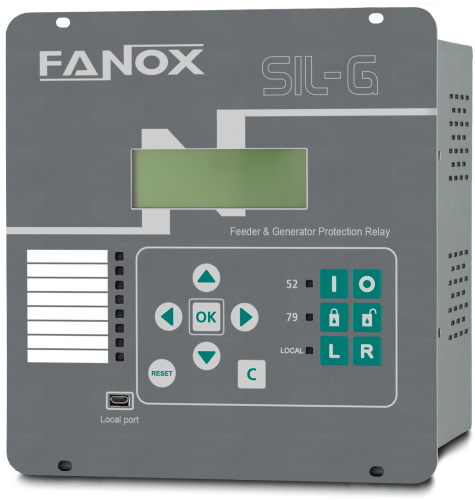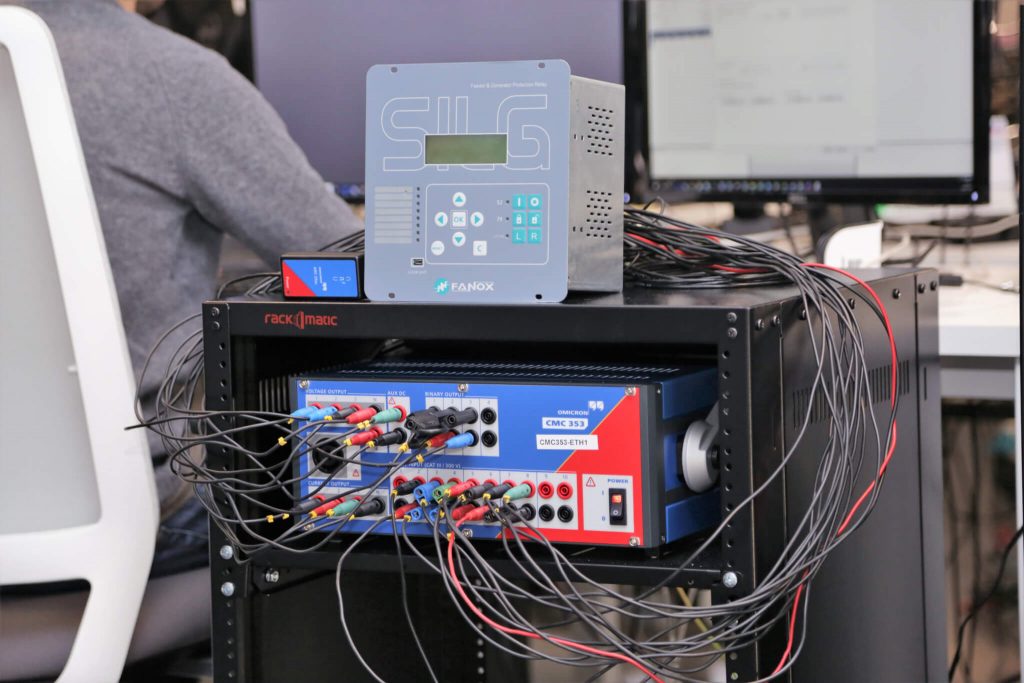SIL-G - Zabezpieczenie pola zasilającego i generatora
The SIL-G is a perfect protection relay for primary distribution which can protect a feeder by means of current, voltage and frequency functions.
It also has the advantage to provide with the main functions to protect a generator protecting decoupling, load shedding and loss of main (islanding). It is normally used with a circuit breaker as cutting element.
Besides, It provides a complete protection working with auxiliary power supply 24-220 Vdc/48-230 Vac or in self-powered mode through the VTs (depending on model).
Integrating the synchronization capability into the generator protection relay through IRIG-B and SNTP optional and Arc Flash detection (AFD) with 4 AFD inputs and 4 high-speed outputs available depending on model provides the most reliable solution.
Main applications: Renewable energy facilities and 36 kV / 66kV / 132 kV substations.


Dokumenty
- Karty katalogowe
- Instrukcje instalacji
- Opis protokołów komunikacji
- Instrukcje użytkownika
Charaktrystyka
- The SIL-G is a feeder relay with current, voltage, and frequency functions for primary and secondary distribution with an auxiliary power supply of 24-230 Vdc/ac, 48-230 Vdc/ac, 24 48 Vdc, or in self-powered mode through the VTs (depending on model).
- The capability of measuring up to 1.000 volts when it is connected directly to the low voltage line.
- Metallic box with high electromagnetic compatibility level (EMC) and wide range of operating temperature.
- Protection of decoupling, load shedding, and loss of main (islanding). Loss of Main (islanding) occurs when part of the public utility network loses connection with the rest of the system. If this situation is not detected, then the generator could remain connected, causing a safety hazard within the network. Automatic reconnection of the generator to the network may occur causing damage to the generator and the network. SIL-G protection relay detects this situation thanks to its voltage and frequency functions focused on the Rate of change of frequency (ROCOF) method.
- Signaling/control of the circuit breaker (52 function) and the recloser (79 function).
- Arc Flash detection (AFD) with 4 AFD inputs and 4 high-speed outputs available depending on the model. This functionality, along with the possibility of having WIFI communication, allows the users to set and configure the relay through Fanox free software and to operate the relay without being present in the installation prioritizing the security.
- Zone selection interlocking – ZSI (68 function) is available through configurable inputs and outputs thanks to the programmable logic (PGC).
- In case a CB is manually closed, a switch on to an existing fault may occur. This fault condition is critical if the overcurrent protection function does not clear the fault until the adjusted time delay is finished. It is necessary, in those cases, to clear the fault quickly by means of the SOTF function.
- To allow the communication, relays are provided with a local micro USB front port and with remote communication with different options (ports and protocols) on the rear side:
- Rear RS485 Port: IEC60870-5-103, Modbus RTU or DNP3.0 Serial.
- Rear RJ45 Port: Modbus TCP/IP, DNP3.0 TCP/IP or IEC61850.
- Rear FO-LC: IEC61850 and Redundancy (PRP or HSR).
- Synchronization through IRIG-B optional depending on the model.
- The SIL-G is provided with (depending on model):
- 8 configurable inputs and 7 configurable outputs.
- 24 configurable inputs and 7 configurable outputs.
- 8 configurable inputs and 18 configurable outputs.
- 16 configurable inputs and 11 configurable outputs.
- 8 configurable inputs, 7 configurable outputs, 4 AFD inputs, and 4 High-Speed outputs.
- SIL-G is fitted with the demand of power (Load Data Profiling) with the following characteristics:
- The number of records: 2160.
- Recording mode circular.
- Sampling rate (interval): configurable through communications (1-60 min).
- The alarm panel is available.
- SIL-G is provided with non-volatile RAM memory in order to store up to 3072 events and disturbance fault recording (DFR), maintaining date & time thanks to its internal RTC (Real Time Clock).
- 5 records in data and COMTRADE format (260 cycles each record): 1 to 8 pre-fault cycles + 252 to 259 postfault cycles.
- 25 records in data and COMTRADE format (60 cycles each record): 1 to 8 pre-fault cycles + 52 to 59 postfault cycles.
- 50 records in data and COMTRADE format (30 cycles each record): 1 to 8 pre-fault cycles + 22 to 29 postfault cycles.
- 100 records in data and COMTRADE format (15 cycles each record): 1 to 8 pre-fault cycles + 7 to 14 postfault cycles.)
- The oscillography is downloaded by the communications port. The SICom communications program allows the oscillography record to be downloaded and saved in COMTRADE format (IEEE C37.111-1991).
Kody funkcji ANSI
50 Instantaneous Phase Overcurrent
67 Inverse Time Directional Phase Overcurrent
50N Instantaneous calculated neutral Overcurrent
50G Instantaneous Measured Neutral Overcurrent
67N Inverse Time Directional Calculated Neutral Overcurrent
67G Inverse Time Directional Measured Neutral Overcurrent
SOTF Switch On To Fault
46 Phase Balance Current Protection
46BC Broken Conductor Detection
37 Instantaneous phase undercurrent
49 Thermal overload
SHB Second Harmonic Blocking
59 Instantaneous phase overvoltage
59N/G Instantaneous Calculated/Measured neutral overvoltage
59L Instantaneous Line overvoltage
47 Phase Balance voltage protection
27 Instantaneous Phase Undervoltage
27L Instantaneous Line Undervoltage
27V1 Instantaneous Positive sequence Undervoltage
32 Directional Overpower
81O/U Under/Overfrequency
81R Rate of change of Frequency (ROCOF)
78 Out of Step (Vector Shift)
24 Overfluxing
CLP Cold Load pickup
79 AC Reclosing device
52 Breaker Wear Monitoring
25 Synchro Check
50BF Circuit Breaker Failure
74TCS Trip Circuit Supervision
60CTS Phase CT Supervision
60VTS Phase VT Supervision
AFD Arc Flash detection
86 Trip Lockout
68 Zone selection interlocking
PGC Programmable logic control

Oprogramowanie
Oprogramowanie komunikacyjne dla przekaźników zabezpieczeniowych SIA i SIL
Oprogramowanie SICom na komputery PC zostało stworzone dla umożliwienia dostępu do wszystkich informacji gromadzonych w przekaźnikach Fanox, modyfikacji nastaw i konfiguracji, sprawdzenia stanów i pomiarów oraz analizy i zapamiętywania raportów zdarzeń z wykorzystaniem interfejsu przyjaznego dla użytkownika.
SICom pracuje w systemach operacyjnych Windows® Windows 7, Windows 8, Windows 8.1 oraz Windows 10.
- Odczyt danych ogólnych: Pełna identyfikacja modelu, wersja oprogramowania, numer seryjny, itp.
- Odczyt stanów
- Odczyt pomiarów
- Odczyt i zmiana nastaw
- Odczyt i zmiana konfiguracji
- Odczyt i kasowanie zdarzeń
- Odczyt i kasowanie raportów o błędach
- Odczyt i kasowanie danych o zapotrzebowaniu (profilowanie danych obciążenia)
- Odczyt i zapamiętywanie rejestrów oscylograficznych w formacie Comtrade
- Zmiana hasła użytkownika
- Zapamiętywanie i ładowanie Polików nastaw
- Zapamiętywanie i ładowanie plików konfiguracyjnych
- Zapamiętywanie raportów zdarzeń i błędów
- Synchronizacja zegara
- Konfiguracja parametrów komunikacyjnych
- Odczyt i zmiana stanu liczników
- Polecenia otwarcia i zamknięcia wyłącznika oraz blokowanie/odblokowanie reklozera
- Konfiguracja wejść
- Konfiguracja wyjść
- Konfiguracja sygnałów aktywujących raporty o błędach
Aktualizacja oprogramowania nie wymaga żadnego działania ze strony użytkownika, to znaczy, jeśli komputer jest podłączony do Internetu, SICom aktualizuje się sam podczas uruchamiania.
Umożliwia on przygotowanie wszelkich nastaw i konfiguracji przekaźników bez potrzeby podłączania przekaźnika do PC (tryb off-line), oszczędzając czas obsługi i uruchamiania.
SICom wykorzystuje protokół Modbus, więc tylko porty z tym protokołem mogą być wykorzystywane do ustanowienia połączenia.


